In the first three instalments of this blog series, I looked at the life of Arthur Albert Tester, swindler and conman extraordinaire. (Part 1 is here, Part 2 is here, Part 3 is here) In today’s post, I’m going to sweep up the stories of what became of his two wives and six children.
Interestingly, Tester’s birth was finally added to the register of British consular births for 1946-1950, retroactive to 1923 when he received his second (or possibly his first) British passport in Frankfurt am Main. His three eldest daughters, Violet, Margit and Mary, all born in Germany before 1923, were also listed in the 1923 and 1946-1950 consular births register which suggests that their births were not registered with the British consular authorities at the time of their births either. All of this activity in the consular births registers in the post-war period was likely triggered by Tester’s children trying to return to England and finding their path hampered by a lack of adequate documentation. Which begs the question, what became of Tester’s wife and children?
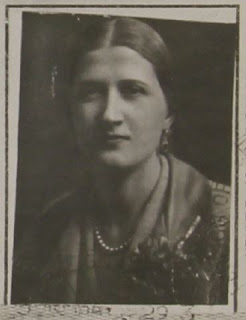
(from National Archives KV 2/617)
Charlotte Elise Uckert (Tester’s Second Wife)
When Tester died (or not) in August 1944, his wife, Charlotte Elise (née Uckert) Tester, was not in the vehicle with him. This would suggest that Tester left his wife and children behind while he tried to escape from Roumania. One MI5 report noted that, in August 1945, Tester’s wife was still in Roumania, suffering from Dipsomania (alcoholism). At some point, however, she must have been able to make her way back to England for in 1948, her step-daughter Margit noted that her step-mother was living in London “somewhere”.
While Tester’s death was never confirmed by the British authorities, his wife, Charlotte went to court to get his estate cleared in the 1950s. On 17 March 1954, the Kansas City Star noted that “a few days ago, the probate court in London gave members of the Tester family permission to presume his death, so that his estate may be settled”. His will was probated a year later, in 1955, although I have yet to find a death certificate for Tester. The probate notice states that Tester died on or after August 1944 at some place unknown. The will was administered by Nelly Alice Lucy Ann Tester (spinster) attorney of Robert Eichenbrenner. Nelly was one of Tester’s sisters and Robert Eichenbrenner was the husband of another of Tester’s sisters. I applied for Tester’s probate records since it seemed like they might be interesting.
The original will listed Fred Tester (father), Thomas Maslin Harris (business partner) and Eva Lawrence (Tester’s secretary) as the executors. Should his father be unable to act, Tester appointed his brother-in-law, Robert Eichenbrenner, as executor. Since Tester’s father died 5 November 1940 in Stuttgart, it would appear that Eichenbrenner’s role kicked into effect. But when the will came to be probated in 1955, Eva renounced her role and since Eichenbrenner resided out of the country, Nelly was appointed attorney of Eichenbrenner. I can only presume that Thomas Maslin Harris was deceased by this point since his role as executor is not addressed at all in the probate documents. A quick side note, Tester’s mother, Emma (née Kauffelin) was still living in Stuttgart in the 1955 address books.
Tester wrote his will on 20 December 1938, a few days before he headed off into the Mediterranean aboard the SY Lucinda. A few items are of note:
- Tester wished to be cremated, unless he was buried at sea, but it was his “express and earnest wish” that none of his family attend his funeral or wear mourning
- To his son, Fred Tester (born of his first wife), Tester bequeathed the sum of £1 (one pound) – rather a slap in the face I should think
- To his son, Arthur, he gave all his personal belongings
- The rest of his personal property was to be held in trust.
- Income from his investments was to be paid to his wife, Charlotte, who was to educate and support his five children until the age of 21 years (or if they married before then). Thereafter Tester was confident that his wife would give the children as much support as they might need
Mary Tester (born 1922 in Eltville, GER)
We can piece together a bit of Mary’s post-war life from the MI5 files on Tester. In December 1947, one Adolph Pawel Obler (born 4 August 1902 in Chorostkow, Poland) a Jewish dentist, applied for a visa to enter the UK and visit his fiance, Mary Tester. The British authorities questioned Mary Tester quite extensively and looked into the background of Obler. Given that Mary’s father was the infamous Arthur Albert Tester, the authorities were naturally a little wary of his children. Mary said that she had quarrelled with her father about his support for the Germans and run away while in Roumania, finding shelter with Obler (20 years her senior). She claimed to have helped the British and that she had arrived back in the UK in September 1947. Despite MI5s misgivings about Obler (he had had some questionable associations with the Romanians), the Foreign Office approved a visa for Obler in June 1948. There is, however, no evidence that he actually came to England. In fact, it would appear that in 1952, Obler emigrated to Canada and married Anna Francisca Mastna in Quebec. Obler passed away in 1966 and is buried in Toronto with his wife. As for Mary Tester, I have yet to discover what became of her.
Margit Tester (born 1921 in Wiesbaden, GER)
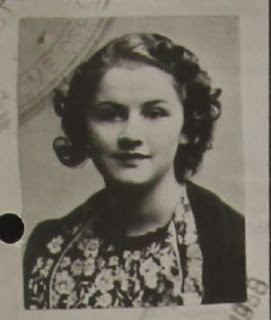
(from National Archives KV 2/617)
On 22 January, 1948, Margit (née Tester) Ghibaldan, the divorced wife of a Romanian subject, requested an emergency certificate to come to the UK with her two infant children. She wanted to regain her British nationality, despite the fact that her father had failed to register her birth at a British consulate within the stipulated period. She stated that she had lived in the UK since being an infant.
Margit had married a Romanian in 1940 while a minor but was now divorced and alone with her two small children in Roumania. The MI5 report noted that she had married a pro-Nazi lawyer named Ghibaldan – likely Valeriu Ghibaldan (1897-1978) listed as being a lawyer in Bucharest in newspapers from 1947. One MI5 report noted that Ghibaldan was on the Passport Office black list. Margit stated that her mother (step-mother Charlotte) and sister (likely Mary) were both in the UK. MI5 expressed no objection to her being granted a visa. There is no information on when Margit re-entered the UK.
It would appear that in the last quarter of 1951, Margit married a man named Sydney Harris/Herscooici. Margit’s name was listed as “Marget Tester or Ghibaldan”. Finally, at some point, she also married a man named Watts before passing away on 7 March 2008 in Walton-on-Thames, Surrey. Margit had two small children in her care when she came back to England, at least one of whom was a son who passed along the Ghibaldan surname to his children and grandchildren. Margit’s first name gets variously misspelled as Margot/Marget.
Fred Tester (born 1924 in Eltville, GER)
Fred Tester, the eldest son of Tester, was born February 1924, after his mother, Ingeborg had already left Arthur Albert Tester. Ingeborg moved to Hamburg with her infant son and Tester apparently had little to no contact with Fred.
There were, however, rumours about Fred Tester circulating through the intelligence community. In 1939, one report noted that Fred Tester was reportedly in the German Air Force which, given that he was 15 years old at the time, seems a bit of a stretch. Another report noted that Fred had a great talent and was being prepared for the career of a professional musician at the Conservatory in Kiel.
Whether Fred served in the German Air Force is unknown. He did not, however, live a long life. On 9 October, 1950, at the age of 26 years, Fred died in St. George’s Hospital in Hamburg. He was not married and died of a rather odd and rare malady: highly feverish Bulbar Paralysis (hochfieberhafter bulbärparalitischer prozeß). From what I can gather, Bulbar Paralysis is a progressive disease, of unknown origin, marked by progressive paralysis and atrophy of the lips, tongue, pharynx, and larynx. Not a pleasant way to go I would imagine. His occupation was listed as “Correpetitor” which is an accompanist, coach or tutor of ballet dancers or opera singers. This definitely jives with the MI5 report which noted that he was being prepared for the career of a professional musician. I presume that Tester’s bequest of £1 to his son Fred was divided equally among the remaining five children when the will was probated in 1955.
I should note, in passing, that the first wife of Arthur Albert Tester, Ingeborg, was still alive in 1950 when her son passed away. Her ultimate fate is unknown but she still appears in the Hamburg address books in 1960.
Ingeborg Violet Tester (born 1918 in Wiesbaden, GER)
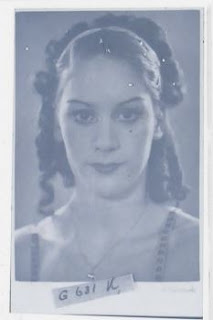
(from National Archives KV 2/616)
As for Violet, Tester’s eldest child, she had a much more challenging time in returning to England and her journey can only be pieced together by newspaper reports.
It would appear that, when Tester left England in 1938, Violet was a dancer with the Hamburg Opera House. She also spent time in Vienna as a dancer and one article noted that in 1938, she was the prima ballerina at the Vienna Opera. A photo of Violet posted on GettyImages notes that she was a Principal Dancer at the Vienna State Opera in 1943. This does not, however, mean that she was a lead dancer. The Wiener Staatsoper site has a list of ballets in which Violet performed from 1940 to 1943, and she never seems to have had a leading role. Her last ballet in Vienna finished on 1 July 1943 and it seems likely that she then moved to Roumania. The MI5 records for Arthur Albert Tester don’t have a lot of information on Violet other than noting that she married a Romanian named Ghibaldan (possibly a brother of Valeriu Ghibaldan) in 1944.
The newspapers from the mid-1950s, however, have a fair bit about Violet as she was finally given permission to leave Roumania and travel to England. One representative article from 22 August 1955 gives a good summary of the story:
British ballerina returns from behind Iron Curtain
Yorkshire Post and Leeds Intelligencer – 22 Aug 1955
Mrs. Violet Tester, the 34-year-old British ballerina, who has been trying to leave Rumania for five years, arrived in Paris today on the Arlberg express from Vienna after leaving Bucharest on Friday. Later in the day she left for London by way of Calais.
Mrs. Tester, a slim, attractive woman with blonde curling hair, was prima ballerina at the Bucharest State Opera Company from 1946.
She said on arriving in Paris: “I am overjoyed to be returning to England, which I have not seen since my childhood. I have no money, so I hope to find a job
dancing–perhaps at Sadler’s Wells–when I arrive there.”
‘Terribly long wait’
Five years ago she applied in Bucharest to return to Britain. She is one of the four British wives known to have been trying to come home.
“I have had to wait a terribly long time,” she said. “They refused to give me permission.”
Mrs. Tester declined to say anything about her experiences behind the Iron Curtain.
Questioned about reports that her father, the British born Dr. Arthur Albert Tester, a reputed millionaire, was shot while fleeing from the Russians in Rumania, she said: “All I know is that I received a report while in Rumania that he was shot on August 25, 1944–the day of the ‘liberation’ in Rumania.”
No friends to meet her
She said she had no friends or relatives to meet her in London. “My brother left Rumania several years ago and went to Australia and I have a half-sister in England, but I do not know where she is. I will be starting my life all over again.
“I married a Greek-born ballet master while I was in Bucharest. We were divorced three years ago.”
After the divorce she decided to resume her maiden name.
Mr. Anthony Nutting, Minister of State, announced in the House of Commons last month that Rumania had granted Mrs. Tester a visa. The British Legation in Bucharest had made an application in 1952 for her to leave.
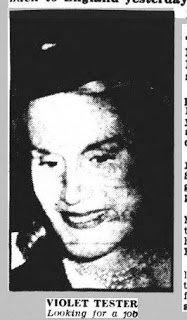
A much better photograph is viewable on Shutterstock
Later that day, when Violet stepped off the train in London, she apparently told a Daily Herald reporter that “As far as I know, my father had no Nazi sympathies”. Which stands in stark contrast to Mary’s statement that she ran away from her father in Roumania because she didn’t agree with his German activities. The Daily Herald paper also notes that Violet “will see lawyers about her father’s estate in this country, estimated at £25,000 and now handled by the Custodian of Enemy Property.”
Interestingly, the Belfast News-Letter, noted that when Violet arrived at Victoria Station, she was hustled through a crowd of reporters and photographers to a taxi. “She refused to speak to the reporters. She was met on the platform by two women”. The same article also has several statements given by Violet, but these may have come from her interviews with reporters in Paris from earlier in the day. The reference to the two women who met her on the platform is intriguing and I would imagine that these might be her sisters, Mary and Margit, or perhaps one was her step-mother, Charlotte. Clearly, given what we know of her step-mother and sisters, Violet had more than just a “half-sister” (likely Lilian) in England. What became of Violet after she stepped off the train is unknown. She passed away on 19 December 1991 at White Oaks Nursing Home in Uckfield, East Sussex.
Arthur Uckert/Tester (born 1925 in Wiesbaden, GER)
As for Tester’s illegitimate son, Arthur Uckert… we don’t really know much. Violet says that her brother went to Australia… but I have found no evidence to confirm this. One Romanian article said that Arthur Tester was in dealing arms in the Middle East in the 1950s and one article suggested this might actually be Arthur Uckert. Beyond that… Arthur Uckert and Arthur Tester are both too common to trace with any certainty.
Lilian Tester (born 1932 in Broadstairs, England)
Finally, we come to the youngest of the Tester children. In 1955, Violet noted that she had a half-sister living in England, likely a reference to Lilian. I did find a family tree (it just went up on 7 July 2020) on Ancestry which seems to refer to Lilian Tester, born 29 April, 1932 in Broadstairs. According to the very scant information on the tree, Lilian married Marc Callaghan (1920-1962). Marc passed away in France on 9 January 1962, suggesting Lilian may have been living there as well. Lilian herself passed away last year, on 10 May 2019, in London.
Conclusion
And… we reach the conclusion of this four part saga of Arthur Albert Tester. With more questions, it seems, than answers. I do think, however, I have a fairly good sense of the man and his mode of operation. Which will help me in piecing together a bit more of the story of Josef Emil Roos, the man who was associated with a scheme to secure Irish naturalizations for Jews desirous of leaving Germany. A bit of a round-about route to get to this point but… Tester’s role seemed to be important…
Sources
National Archives (Kew) – Security Service files on Arthur Albert Tester (KV 2/616, 2/617, 2/618, 2/2266)
Metropolitan Police – FOI publication of MEPO 38/95 – police file on Arthur Albert Tester
The London Gazette – various notices
The British Newspaper Archives – various articles
Ancestry – genealogical records
FindmyPast – genealogical records
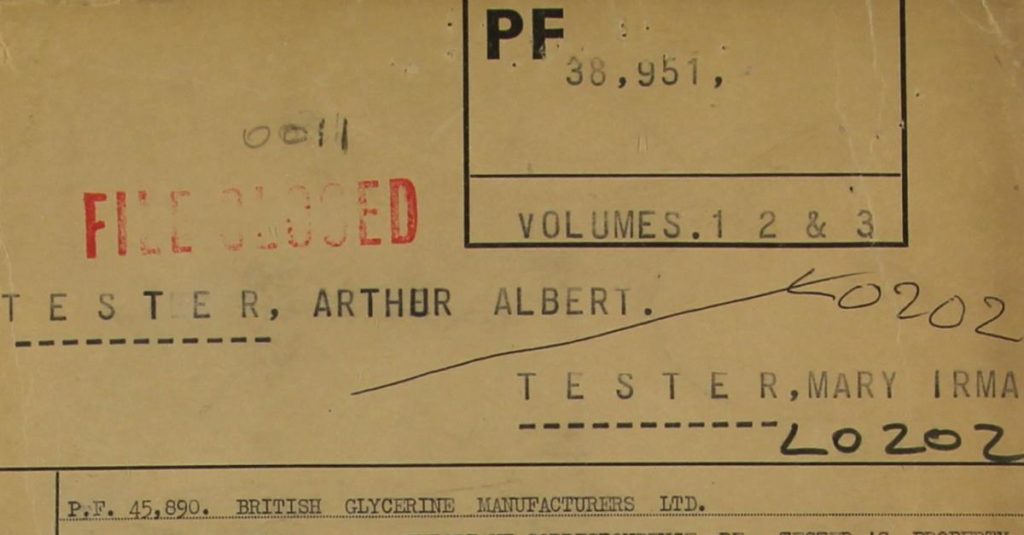
From Jean Ancel, The History of The Holocaust in Romania, p. 147: « The Gestapo agent Arthur Tester (who,in late 1942, played an important role in the abortive attempt to organize the emigration of seventy thousand Jews from the Transnistrian ghettos and camps to Palestine) got rich during Legionary rule by stripping Jews of their property with the help of Legionary associates. »
This is complemented by a very informative footnote to be consulted at the end of the book.
Thanks Jean-Bernard!